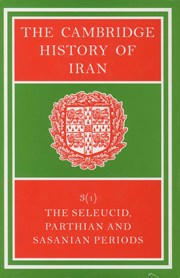Crossref Citations
This Book has been
cited by the following publications. This list is generated based on data provided by Crossref.
Sabin, Philip
van Wees, Hans
and
Whitby, Michael
1920.
The Cambridge History of Greek and Roman Warfare.
Flood, F. B.
1991.
Mobility and Mutation: Iranian Hunting Themes in the Murals of Alchi, Western Himalayas.
South Asian Studies,
Vol. 7,
Issue. 1,
p.
21.
Gafni, Isaiah M.
2006.
The Cambridge History of Judaism.
p.
792.
Rukuni, Rugare
2020.
Religious statecraft: Constantinianism in the figure of Nagashi Kaleb.
HTS Teologiese Studies / Theological Studies,
Vol. 76,
Issue. 4,
de Gruchy, Michelle
Jotheri, Jaafar
Alqaragholi, Hayder
Al-Janabi, Jassim
Alabdan, Raheem
Al-Talaqani, Haneen
Almamouri, Ghadeer
and
Al-Rubaye, Hajir
2021.
The Khandaq Shapur: Defense, Irrigation, Boundary, Frontier.
Land,
Vol. 10,
Issue. 10,
p.
1017.
Overtoom, Nikolaus Leo
2021.
Reassessing the Role of Parthia and Rome in the Origins of the First Romano-Parthian War (56/5–50 BCE).
Journal of Ancient History,
Vol. 9,
Issue. 2,
p.
238.
Simonen, Katariina
2021.
Ancient Water Agreements, Tribal Law and Ibadism.
p.
15.
Mirvahedi, Seyed Hadi
and
Nawasser, Kamal
2024.
Towards conceptualizing ‘demographic agency’ in Family Language Policy.
Sociolinguistic Studies,
Vol. 18,
Issue. 1-2,
p.
175.



